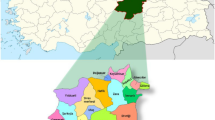Abstract
The authors located and experimentally reproduced an alcoholic beverage using Schinus molle L. drupes to explain the presence of large quantities of S. molle seeds in archaeological contexts associated with the Middle Horizon (550–1000 C.E.) site of Cerro Baúl, Moquegua, Perú. They discuss the production ofchicha de molle in the context of the archaeological site, the ecology of the plant, and the ethnobotany associated withS. molle in the Andes. Overall, S. molle was and is used today in a variety of ways regionally, and through both ethnobotanical and archaeological fieldwork, they establish a long-standing tradition of human-plant interactions withS. molle.
Similar content being viewed by others
Literature Cited
Ansión, J. 1986. El Arbol y el Bosque en la Sociedad Andina. FAO/INFOR, Lima.
Barkley, F.A. 1944.Schinus L. Brittonia 5(2): 160–198.
Brack Egg, A. 1999. Diccionario Enciclopedico de Plantas Utiles del Peru. Centro Estudios Regionales Andions “Bartolome de las Casas”, Cuzco.
Cabieses, F. 1993. Apuntes de Medicina Tradicional: La Rationalizatión de lo Irrational. Consejo National de Ciencia y Tecnologia, Lima.
Camino, L. 1987. Chicha de Maíz: Bebida y Vida del Pueblo Catacaos. Centro de Investigation y Promotión del Campesinado, Piura, Perú.
Cardenas, M. 1969. Manual de Plantas Económicas de Bolivia. Imprenta Icthus, Chochabamba.
de Costa, P. J. 1954(1590). Historia Natural y Moral de las Indias. In P. F. Mateos, Obras del P. Jose de Acosta. Biblioteca de Autores Espanoles. Ediciones Atlas, Real Academia Espanola, Madrid.
de Cieza de León, P. 1924(1553). La Crónica General del Perú. In H. H. Urteaga, Historiadores Clasicos del Peru, Lima. Vol. 7.
Cohen, M. N. 1972–74. Some problems in the quantitative analysis of vegetable refuse illustrated by a late horizon site on the Peruvian coast. Ñawpa Pacha 10–12:49–60.
—. 1978. Archaeological plant remains from the Central Coast of Peru. Ñawpa Pacha 16:23–51.
Cook, A., and M. Glowacki. 2003. Pots, politics, and power: Huari ceramic assemblages and imperial administration. Pages 173–202 in T. Bray, ed., The archaeology and politics of food and feasting in early states and empires. Kluwer Academic Publishers, New York.
Garcilasode la Vega,El Inca. 1829(1609). Historia de la Conquista del Nuevo Mundo, Tomo III. Imprenta de los Hijos de Doña Catalina Piñuela, Madrid.
Harker, A. P., A. Sandels, and J. Burley. 1982. Calorific values for wood and bark and a bibliography for fuel wood. Tropical Products Institute Technical Report G 162. ODA.
Kramer, F. L. 1957. The pepper tree,Schinus molle L. Economic Botany 2(4):322–326.
MacBride, J. F. 1936-71. Flora of Peru. Field Museum of Natural History, Botanical Series, Chicago.
Moore, J. D. 1989. Pre-Hispanic beer in coastal Peru: Technology and social context of prehistoric production. American Anthropologist 91:682–695.
Nash, D. N. 2002. The archaeology of space: Places of power in the Wari Empire. Ph.D. dissertation, University of Florida, Gainesville.
Record, S. J., and R. W. Hess. 1972(1943). Timbers of the New World. Arno Press, New York.
Ruiz, H., and J. Pavón. 1995(1798). Flora Peruviana et Chilensis. Ediciones Doce Calles, Madrid.
Sayre, M. 2003. New paleoethnobotanical evidence from Conchopata: A Huari site. Paper prepared for the symposium, Recent Work at Conchopata Symposium, organized by A. Cook and B. Isbell at the 68th Society for American Archaeology Annual Meeting, March 2003, Milwaukee, WI.
Terrell, J. E., J. P. Hart, S. Barut, N. Cellinese, A. Curet, T. Denham, C. M. Kusimba, K. Latinis, R. Oka, J. Palka, M. E. D. Pohl, K. O. Pope, P. R. Williams, H. Haines, and J. E. Staller. 2003. Domesticated landscapes: The subsistence ecology of plant and animal domestication. Journal of Archaeological Method and Theory 10:323–368.
Valencia Quispe, R. N., and D. J. Goldstein. 2004. Putting the food on the Mesa: Paleoethnobotanical investigations at Cerro Baúl, Part 1. Paper prepared for the symposium, Production and Consumption on the Wari-Tiwanaku Frontier, organized by P. R. Williams at the 69th Annual Meeting of the Society for American Archaeology, March 31-April 4, 2004, Montreal, Canada.
Weberbauer, A. 1945. El Mundo Vegetal de los Andes Peruanos. Ministerio de Agricultura de Perú, Lima.
Williams, P. R., and M. Ruales. 2002. Informe de Campo e Informe Final Proyecto Arqueologico Cerro Baúl 2001. Museo Contisuyo, Moquegua, Perú.
Yacovleff, E., and F. L. Herrera. 1935. El Mundo Vegetal de los Antiguos Peruanos. Revista del Museo Naciónal, Lima 4:33–34.
Author information
Authors and Affiliations
Corresponding author
Rights and permissions
About this article
Cite this article
Goldstein, D.J., Coleman, R.C. Schinus molle L. (Anacardiaceae)Chicha production in the Central Andes. Econ Bot 58, 523–529 (2004). https://doi.org/10.1663/0013-0001(2004)058[0523:SMLACP]2.0.CO;2
Issue Date:
DOI: https://doi.org/10.1663/0013-0001(2004)058[0523:SMLACP]2.0.CO;2




